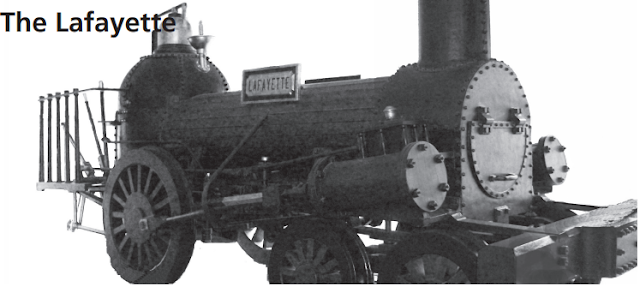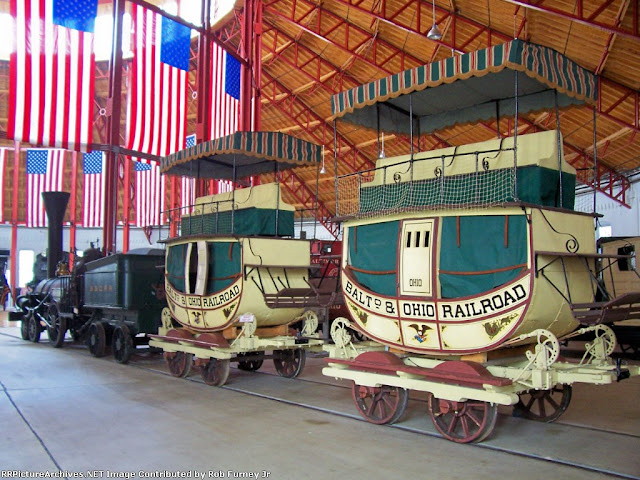In 1927, B&O built a replica of their 1837-built Lafayette. That is why there are two dates in the title.
It visited Chicago in the 1830s for the Century of Progress and then again for the 1948 Railroad Fair in Chicago.
 |
| Mike Breski posted Photo gallery: Railroad Fair Baltimore and Ohio locomotive Lafayette build in 1837 is being unloaded for display at the Chicago Railroad Fair in 1948. — Chicago Tribune Bob Lalich: Interesting photo! I can't place the location. The IC MOW equipment suggests an IC yard but that may not be the case. [The coaling tower in the left background is rather unique. But I don't know which railyard it was in.] David Dauszka shared |
 |
| Dennis DeBruler commented on David's share Lafayette is a 1927-built replica of the 1837 locomotive built by Norris. It was the first locomotive to have a truck in the front, and it was the first one for B&O that had a horizontal boiler. It looks normal to us, but that design was revolutionary in its day. As an example of a normal design in 1837, I include a photo of the 1830 Best Friend of Charleston, which was also at the fair. This 1830 locomotive pulled the first train with paying passengers in America. It pulled 141 people on Dec 25, 1830 from the Camden depot in Charleston, SC. Adding the front truck not only made it safer to go around sharper curves, it allowed the boiler to rest on a triangle instead of a rectangle. Because much of the track in America was a lot more uneven than the track in England, the tripod mounting better accommodated the uneven track. After another driver axle was soon added for more power, we have the American 4-4-0 design that prevailed for decades. The replica is housed in the B&O Museum, and it was made operational in 2002. |
 |
| Andy Kowalczyk commented on Dennis' comment Lafayette replica at the rail museum in Linden, Indiana http://www.lindendepotmuseum.org/ |
 |
| B&O Railroad Museum tweet Norris Locomotive Works built the Lafayette for the B&O in 1837. The 4-2-0 engine was the 1st locomotive to feature a leading truck that swiveled as the engine went around curves in the track. The 1927 replica displayed at the B&O has been used in films such as Amistad |
 |
| RailArchive "With cylinder dimensions of 9x18 inches, a 90-pound boiler pressure and 48-inch drivers, she produced 2,323 pounds of tractive effort. Locomotive and tender together were 29 feet long and weighed 41,120 pounds." [So it evidently visited Chicago at least twice. Once in the 1930s for the Century of Progress and then again in the 1940s for the Chicago Railroad Fair.] |
 |
| NPS A model had been built for the World's Columbian Exposition of 1893. "Early in the 1830s and 1840s when American railroads were shorter and handled much lighter loads, their needs were better served by a variety of locomotives, of which the 4-2- 0 was clearly the most popular. The numbers 4-2-0 correspond to the placement of the drive wheels on the engine. "Adapted in 1832 by John B. Jervis from the locomotive designs of the British builder Edward Bury - and so occasionally known as the Jervis type- the design gained universal acceptance. By 1840 almost two-thirds of all engines operating on American lines were 4-2-0s. The most renowned and largest builder of the 1840s, the Norris Locomotive Works of Philadelphia, became especially noted for this type. Through its aggressive salesmanship, the Norris firm not only sold hundreds of these locomotives to U.S. railroads like the Allegheny Portage, but exported them abroad to Europe. "At home and abroad, then, the Norris 4-2-0 of the 1830s and 40s was recognized as an outstanding example of Yankee engineering and the first truly standard American engine. "Burdened by their limitations, the 4-2- 0s were short-lived as mainline power. The newly introduced (in 1837) 4-4-0 'American' type was fully as fast, but considerably more powerful and better suited to a wide variety of jobs." |
 |
| Mike Fitzpatrick Flickr via Pinterest B&O Steam Days Featuring the Lafayette. This working steam engine engine was built by the Baltimore and Ohio Railroad in 1927 as an exact full-size replica of the early 1837 vintage Lafayette. The original Lafayette was the first steam locomotive to utilize a horizontal boiler. Her general design was the basis for the configuration of locomotives that survived for over 100 years until the end of the steam engines in the mid 20th century. |
 |
| Bob Furney Jr |
The original had 48" drivers and the replica has 42" drivers. The replica was built for the "Fair of the Iron Horse." It was made operational again in 2002. [SteamLocomotiveInfo]
 |
| Photo by John Kusching, 8th photo in RadioMuseum |
 |
| Bill Hazzard posted I found some early locomotive prints online which I would like to share here. I think that they are all pre 1860. The first one is of the Eastwick and Harrison's patent improved locomotive, manufactured at their works, Twelfth and Willow Street, Philadelphia. 1842. Robert Lang: That print was published in 1843, in the Journal of the Franklin Institute. Here is a link to the article on the locomotive. https://babel.hathitrust.org/cgi/pt?id=hvd.32044102912979... |
%20Pre1895%20Railroads%20&%20Steam%20Engines%20_%20I%20found%20some%20early%20locomotive%20prints%20o.png) |
| Comments on Bill's post |

No comments:
Post a Comment